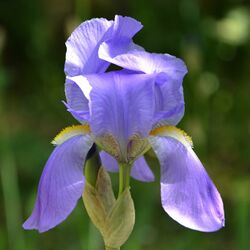Biology:Iris pallida
| Iris pallida | |
|---|---|

| |
| Scientific classification | |
| Kingdom: | Plantae |
| Clade: | Tracheophytes |
| Clade: | Angiosperms |
| Clade: | Monocots |
| Order: | Asparagales |
| Family: | Iridaceae |
| Genus: | Iris |
| Subgenus: | Iris subg. Iris |
| Section: | Iris sect. Iris |
| Species: | I. pallida
|
| Binomial name | |
| Iris pallida Lam.
| |
| Synonyms[1] | |
| |
Iris pallida, the Dalmatian iris or sweet iris, is a hardy flowering perennial plant of the genus Iris, family Iridaceae. It is native to the Dalmatian coast (Croatia) but widely naturalised elsewhere. It is a member of the subgenus Iris, meaning that it is a bearded iris, and grows from a rhizome. It adapts well to different environments and is used in many different ways.
Description
This iris prefers rocky places in the Mediterranean and Submediterranean zone and reaches sometimes montane regions at its southern range in Montenegro. It grows to a stem height of 50–80 cm (20–31 in). The leaves are bluish-green in color, and sword-shaped, 40–50 cm (16–20 in) in length, and 2.5–3 cm (0.98–1.18 in) in width. The inflorescence, produced in May/June, is fan-shaped and contains two or three flowers which are usually pale purplish to whitish.
Cultivation
Iris Pallida are valued in the Chianti region of Italy and cultivated specifically due to their fragrance and medicinal properties.[2] It is cultivated as a garden plant, and commercially for extraction of essential oils from its rhizome (orris root) which was used for medicinal purposes for a very long time. However, today orris oil is commonly used to add flavor to foods.[3]
The species successful cultivation is partly due to its ability to adapt well to different environments, whether that be different climates and weather conditions or soils that are not necessarily rich in nutrients. The growth cycle may differ for the Iris pallida based on surrounding temperatures.[2] This includes the flowering of the plant as well. Observations of differing flowering time based on changes in temperature have been noted. Compared with other Iris species, the Iris pallida flowers lasted the longest, however, they took much longer to develop, especially in colder climates.[4]
The variegated cultivar 'Variegata' has gained the Royal Horticultural Society's Award of Garden Merit.[5][6]
Uses
For hundreds of years, the Iris pallida species was used for its medicinal qualities.[3] It is commonly used today to flavor foods and drinks as well as for perfumes or air fresheners which dates back to the 15th century when it was common to use orris dates to leave fresh scents on linens.[3] The plants rhizomes can also be used to make beads for children's teething necklaces as well as rosary beads.[3]
Subspecies
Three subspecies of Iris pallida s.l. are recognised by some authors as species: Iris pallida subsp. cengialti,[1] (with deep purplish flowers) from Slovenia and adjacent Italy, Iris pallida ssp. illyrica,[1] from the North Dalmatian coast, and Iris pallida ssp. pseudopallida from the South Dalmatian coast.
References
- ↑ 1.0 1.1 1.2 "Iris pallida Lam. is an accepted name". theplantlist.org (The Plant List). 23 March 2013. http://www.theplantlist.org/tpl1.1/record/kew-322201.
- ↑ 2.0 2.1 "European Journal of Horticultural Science". doi:10.17660/ejhs.2020/85.2.4. https://www.pubhort.org/ejhs/85/2/4/index.htm.
- ↑ 3.0 3.1 3.2 3.3 Ioana, CRIŞAN; CANTOR, Maria (2016). "NEW PERSPECTIVES ON MEDICINAL PROPERTIES AND USES OF IRIS SP.". University of Agricultural Sciences and Veterinary Medicine (1–2). https://www.researchgate.net/publication/322937447.
- ↑ CRIȘAN, IOANA; Stoie, Andrei; Buta, Erzsebet; Cantor, Maria (August 25, 2017). "Flowering phenology of some Iris species in the UASVM Cluj agrobotanical garden". Romanian Biotechnological Letters 23 (3). https://www.researchgate.net/publication/327263160.
- ↑ "RHS Plantfinder - Iris pallida Lam. 'Variegata' Hort.". https://www.rhs.org.uk/Plants/95370/i-Iris-pallida-i-Lam-Variegata-Hort-(v)/Details.
- ↑ "AGM Plants - Ornamental". Royal Horticultural Society. July 2017. p. 55. https://www.rhs.org.uk/plants/pdfs/agm-lists/agm-ornamentals.pdf.
External links
- Iris pallida Flora Croatica Database
Wikidata ☰ Q161347 entry
 |

